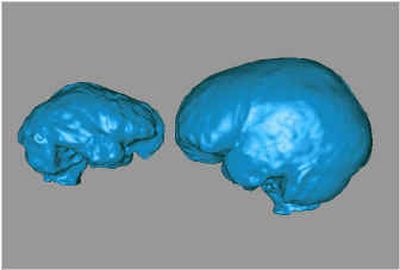Brain not about size, skull study concludes

It’s not the size of the brain that matters. It’s the way it’s arranged. That’s the conclusion of researchers studying the skull of a tiny, Hobbit-like human ancestor who lived on a remote Indonesian island 18,000 years ago.
Researchers reported Thursday that the Hobbit’s grapefruit-size brain had sophisticated characteristics found only in the brains of modern humans. They said the findings offered further evidence that the tiny hunter discovered last year was a unique primitive species that co-existed with modern humans long after its contemporaries were believed to have died out.
“It’s remarkable,” said Florida State University paleoneurologist Dean Falk, leader of the team that studied the skull. “I had a lot of pre-determined ideas. I thought we were going to be looking at a chimpanzee skull, but this has advanced features that I’ve not seen in anything this size.”
Falk’s research, published in the journal Science, was conducted with the cooperation of the Australian-led team that found the fossil and at the behest of the National Geographic Society, which funded the study.
The new research, however, failed to still skeptics who have dismissed the Hobbit as a pygmy-like modern human, or a modern human afflicted with a deformity known as microcephaly – a small head and brain.
The tools and artifacts found with the skull “were made by (fully competent) modern humans,” said paleoanthropologist John Phillips, of the University of Illinois and Chicago’s Field Museum, in a telephone interview. “This individual could not mentally have made them.”
The fossil was discovered in a limestone cave on Indonesia’s Flores Island, which lies immediately east of the so-called Wallace Line dividing islands that once were connected to Australia and Asia and those, like Flores, that remained isolated for millions of years.
The team, led by Michael J. Morwood of Australia’s University of New England, estimated the fossil was 18,000 years old, meaning it had survived long after modern humans appeared about 150,000 years ago and long after the extinction around 30,000 years ago of Neanderthals, the last known archaic human.
The team suggested that the Hobbit exemplified the “island rule” on a human scale: that isolated islands with limited resources and no natural predators cause large animals to get smaller, while small animals get larger. Prehistoric Flores had both miniature elephants and giant Komodo dragon lizards.
The team found remains of seven tiny people, including one nearly complete skull of a 30-year-old woman. They dubbed the fossils Homo Floresiensis, but they quickly acquired the nickname Hobbit after the diminutive characters in J.R.R. Tolkien’s trilogy.
What astounded anthropologists, however, were the sophisticated stone points and barbs found with the remains. Evolutionary orthodoxy holds that advances in human skills like tool-making come with increases in brain size, and such weapons had never appeared anywhere before the advent of modern humans.
The Hobbit, by contrast, had a 25-cubic-inch brain – comparable to primitive human ancestors who lived 2.5 million to 3 million years ago. “It was shocking,” said Rick Potts, director of the Smithsonian Institution’s Human Origins Program, in a telephone interview. “When you thought about it, you realized that (island adaptation) had happened to other mammals, but I was a doubter.”